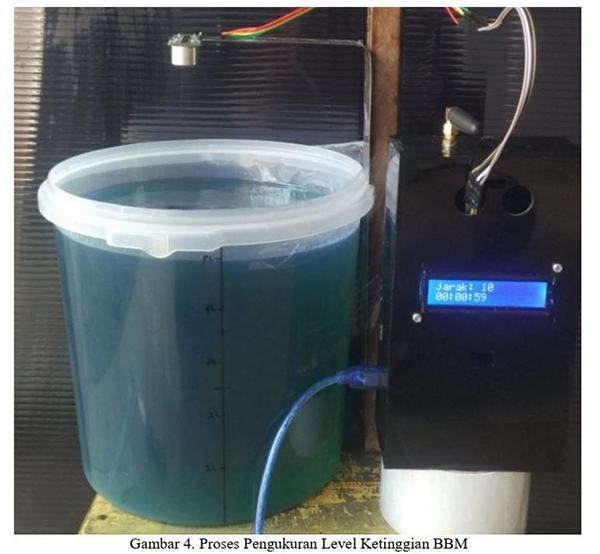Simulation of Telemetry System for Monitoring Fuel Level Based on SMS Gateway
DOI:
https://doi.org/10.12928/biste.v2i1.1604Keywords:
Level Ketinggian BBM, Sensor Ultrasonik HC-SR04, SIM800L, SMS Gateway, Mikrokontroler Arduino UnoAbstract
This study aims to simulate a telemetry system monitoring the level of the fuel level at an SMS-based gas station using an ultrasonic sensor integrated with the Arduino Uno microcontroller. The gas station's fuel tank was simulated using a 5 liter reservoir, while the HC-SR04 ultrasonic sensor was used to detect fuel level. The SIM800L module is used as a sender of information messages about the fuel level at a predetermined condition. This system is equipped with an LCD as a viewer when the data level is read. Based on testing the developed system can function well, shown by the average length of time the process of sending messages from reading the level limit on the tank, until the receipt of messages on mobile phones of 7.6 seconds. While the success rate of reading to the level of fuel level and sending automatic messages on the system reaches 100%.
Penelitian ini bertujuan untuk membuat simulasi sistem telemetri pemantauan level ketinggian BBM di SPBU berbasis SMS gateway menggunakan sensor ultrasonik yang diintegrasikan dengan mikrokontroler Arduino Uno. Tangki BBM SPBU disimulasikan menggunakan sebuah tandon berkapasitas 5 liter, sedangkan sensor ultrasonik HC-SR04 digunakan untuk mendeteksi level ketinggian BBM. Modul SIM800L digunakan sebagai pengirim pesan informasi mengenai level ketinggian BBM pada kondisi yang telah ditentukan. Sistem ini dilengkapi dengan LCD sebagai penampil ketika data level terbaca. Berdasarkan pengujian sistem yang dikembangkan dapat berfungsi dengan baik, ditunjukkan oleh rata-rata lamanya waktu proses pengiriman pesan dari pembacaan level limit on tank, hingga diterimanya pesan pada handphone sebesar 7,6 detik. Sedangkan tingkat keberhasilan pembacaan terhadap level ketinggian BBM dan pengiriman pesan otomatis pada sistem tersebut mencapai 100%.References
D. Setyoko, Tabah Priangkoso, “Analisis Konsumsi Bahan Bakar Sepeda Motor dengan Bahan Bakar Pertamax dan Pertamax Plus Menggunakan Dinamometer Chasis,” J. Ilm. Cendekia Eksakta, pp. 48–54, 2016.
M. S. Tambun, N. Sudjarwanto, A. Trisanto, and A. L. Belakang, “Rancang Bangun Model Monitoring Underground Tank SPBU Menggunakan Gelombang Ultrasonik Berbasis Mikrokontroler,” Electr. – J. Rekayasa dan Teknol. Elektro, vol. 9, p. 2, 2015.
D. D. Rizky Mahardhika, “Sistem Monitoring Level Tangki SPBU dan Mengukur Kadar Air Dalam Tangki,” Simp. Nas. Teknol. Terap., pp. 65–70, 2013.
H. S. Sendi, “Rancang Bangun Sistem Monitoring Jumlah Sisa Volume Minyak Underground Tank Berbasis Mikrokontroler,” J. Teknol., vol. MI, 2018.
C. V. Angkoso, W. Wahedah, and K. Joni, “Monitoring Stasiun Pengisian Bahan Bakar Umum Berbasis Augmented-Reality,” J. Ilm. Rekayasa, vol. 9, no. 2, p. 99, 2016.
R. R. A. Siregar and R. Raymond, “Model Sistem Monitoring Tanki Bahan Bakar Minyak SPBU dengan Menggunakan Web Aplikasi dan SMS Gateway,” JETri, vol. 12, 2015.
Y. Kurniawan, “Implementasi Ultrasonik Level Detektor Pada Sistem Monitoring Tangki Pendam Pada SPBU,” in Proceeding Seminar Tugas Akhir Jurusan Teknik Elektro, vol. 344, pp. 1–6.
H. L. Sunardi, Hari Murti, “Aplikasi SMS Gateway,” J. Teknol. Inf. Din., vol. XIV, no. 1, pp. 30–34, 2009.
Yusman, “Telemetri Pemantauan Ketinggian Air Sungai Melalui Komputer Teroptimasi Data Base Berbasis SMS,” J. Teknol., vol. 13, pp. 25–28, 2013.
D. P. Mangaraja et al., “Implementasi Sistem Pengukuran Otomatis Bahan Bakar di Tangki Genset dengan Sistem Monitoring Berbasis Jaringan,” in e-Proceeding of Applied Science, 2015, vol. 1, no. 3, pp. 2587–2594.

Downloads
Published
How to Cite
Issue
Section
License
Copyright (c) 2020 yuda indra pranata, Muchlas Arkanuddin

This work is licensed under a Creative Commons Attribution-ShareAlike 4.0 International License.
Authors who publish with this journal agree to the following terms:
- Authors retain copyright and grant the journal right of first publication with the work simultaneously licensed under a Creative Commons Attribution License that allows others to share the work with an acknowledgment of the work's authorship and initial publication in this journal.
- Authors are able to enter into separate, additional contractual arrangements for the non-exclusive distribution of the journal's published version of the work (e.g., post it to an institutional repository or publish it in a book), with an acknowledgment of its initial publication in this journal.
- Authors are permitted and encouraged to post their work online (e.g., in institutional repositories or on their website) prior to and during the submission process, as it can lead to productive exchanges, as well as earlier and greater citation of published work (See The Effect of Open Access).
This journal is licensed under a Creative Commons Attribution-ShareAlike 4.0 International License.


